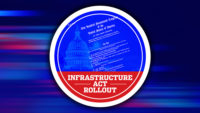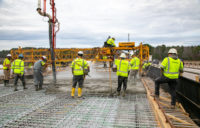The Treasury Dept. has released a list of 40 proposed major U.S. transportation and water infrastructure projects—and two wide-ranging programs—that promise big returns on investment but face funding or other hurdles.
According to the report, released with little fanfare on Dec. 30, the 40 projects’ estimated capital costs total more than $330 billion, but would produce net economic benefits of $500 billion to $1.1 trillion.
The two programs—autonomous vehicles and “recapitalizing” the Interstate Highway System—would cost a combined $2.1 trillion but their benefits would be much higher, the report states.
The study was produced by a team led by AECOM and is part of the Obama administration’s Build America Investment Initiative. That program, launched in 2014, aims to spark more infrastructure investment and draw on the private sector.
The study focuses on projects that have “major economic significance, but whose completion has slowed or is in jeopardy.”
The future impact of the study, released near the end of the Obama presidency, is unclear. President-elect Donald J. Trump has pledged a $1-trillion, 10-year infrastructure plan that, according to a campaign white paper, would involve tax credits.
Brian Pallasch, American Society of Civil Engineers managing director for government relations and infrastructure initiatives, said via email that the Treasury report’s examples of projects that can have significant economic payoffs is “a message ASCE has been sharing for years, and we’re excited that the Treasury took on this research and quantified the benefits.”
The authors note that previous infrastructure “needs” reports include “projects of all sizes and types lumped together.” By contrast, they add, “This study aims to help re-focus the debate on projects with significant national economic benefits relative to their costs.”
The report found that “a lack of funds is by far the most common challenge to completing these projects,” observing that 39 projects face such shortfalls. ASCE’s Pallasch said, “By acknowledging these projects have major ROI and still are not getting funded, it shows the magnitude of challenges facing our infrastructure because of the investment gap.”
Increased costs have hampered 19 projects, and 20 are hindered by a lack of consensus among relevant public- and private-sector organizations.
Only nine face regulatory issues, such as lengthy reviews and permitting processes, the report says. As the numbers indicate, some projects face multiple hurdles.
The list includes 14 highway, 10 rail, nine water-resources and six port or waterway projects.
In terms of projects’ geographic mix, 17 are in the South, eight in the West, seven in the Midwest and three in the Northeast; five others are national in scope.
By far the most costly project, at an estimated $100.8 billion, is a passenger-rail improvement plan for Amtrak’s Northeast Corridor. The California high-speed rail program is next, at $58.8 billion.
Upgrades to Interstate-10, which crosses eight states from Florida to California, would cost $28.6 billion. Ranking fourth is the already-underway- but-still-incomplete Next Generation Air Traffic Control system, or NextGen, at an estimated $25.3 billion.
The fifth-largest project is the Minnesota-to-Texas I-35 Trade Corridor, at $15.6 billion.
The report’s two broad—and extremely expensive—programs are: technology to accommodate autonomous vehicles, pegged at $1.3 trillion in capital costs; and recapitalizing the Interstate system, including additional capacity, estimated at $790 billion.
Despite the daunting price tags, the report says the programs would produce substantial bangs for those megabucks: it estimates the autonomous vehicle plan’s benefits at seven to 10 times its costs; the Interstate plan’s benefit-cost ratio would be between four and seven to one.
The Treasury report isn’t all-inclusive: it omits airport and toll-road projects because, it says, “they do not face the same set of funding and financing hurdles that many other infrastructure projects face.
The study also excludes water and wastewater-treatment projects, “because they are driven by regulations and compliance timetables, not explicit benefit-cost economics.”




Post a comment to this article
Report Abusive Comment